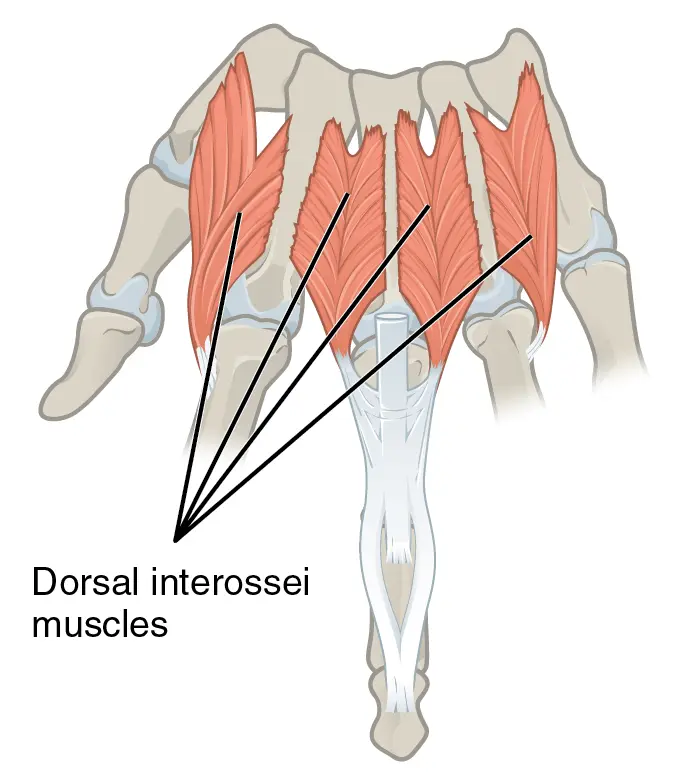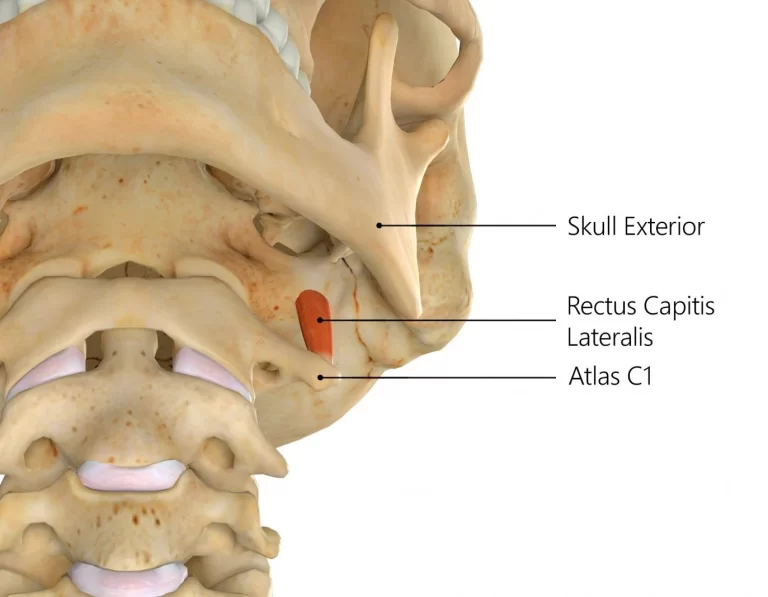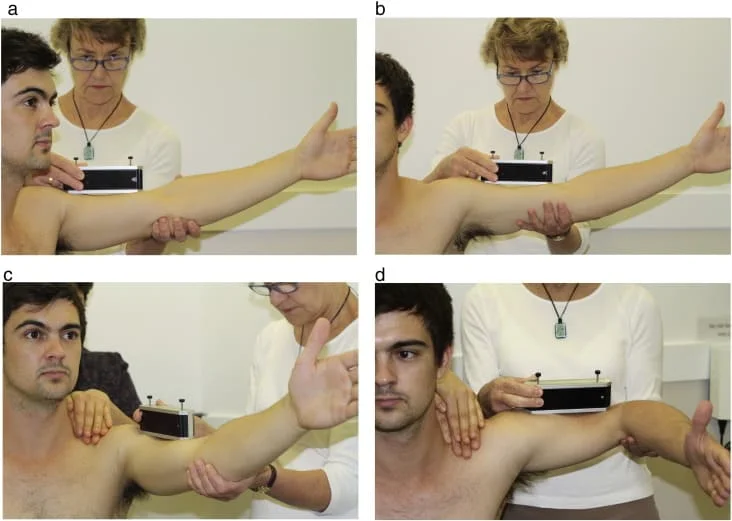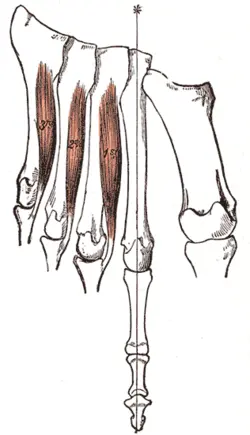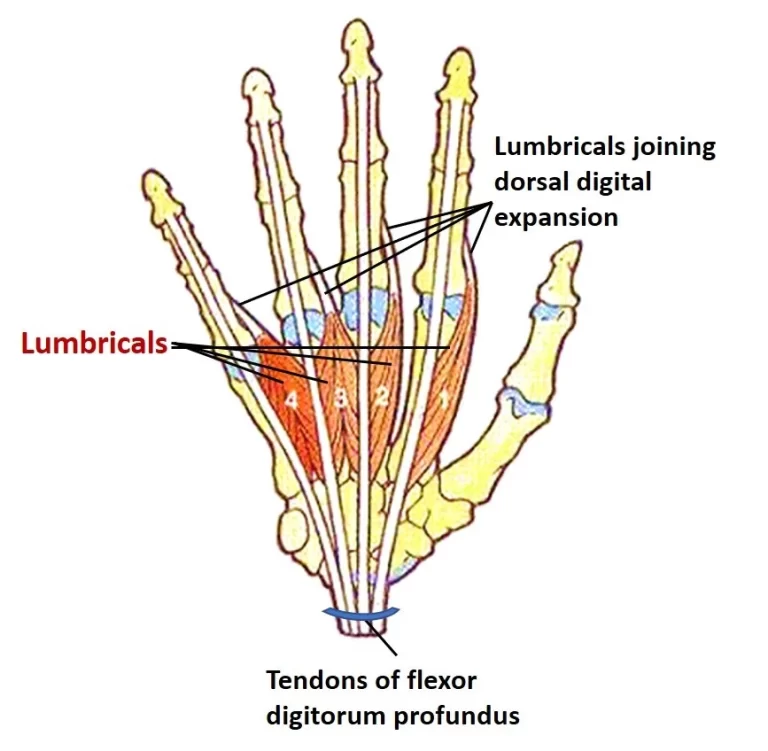Dorsal interossei muscles
What are the Dorsal interossei muscles?
The hand’s short bipennate intrinsic muscles are the dorsal interossei. Along with the palmar interossei muscles, they can be found on the dorsal side of the hand in the space between the metacarpal bones.
The dorsal interossei muscles comprise four short muscles that connect to the adjoining sides of metacarpals 1-4. They abduct the digits 2-4 and help in the flexion and extension of these fingers at the metacarpophalangeal (MCP) and interphalangeal (IP) joints, respectively.
Origins and Insertions of Dorsal interossei muscles
1st muscle
Origin
The lateral side of the second metacarpal and the medial side of the first metacarpal’s proximal end
Insertion
The extensor expansion (Extensor Hood) and the lateral side of the second proximal phalanx’s base
2nd muscle
Origin
The third metacarpal’s lateral side and the second metacarpal’s medial side
Insertion
The extensor expansion and the lateral side of the base of the third proximal phalanx
3rd muscle
Origin
The third metacarpal’s medial side and the fourth metacarpal’s lateral side
Insertion
The extensor expansion and the medial side of the base of the third proximal phalanx
4th muscle
Origin
The fourth metacarpal’s medial side and the fifth metacarpal’s lateral side
Insertion
The extensor expansion and the medial side of the fourth proximal phalanx’s base
Relations
The hand’s dorsal compartment is located in the dorsal interossei muscles. They occupy the interosseous space and are situated deep within the palmar interossei. From each metacarpal bone, two heads form each of the four dorsal interossei. To reach their insertions, the tendons of the dorsal interossei traverse the deep transverse metacarpal ligament’s posterior side.
A triangular space between the roots of the digits is created by the carpometacarpal joints and the origin fibers of the dorsal interossei. Some of the hand’s arteries pass through this space. The perforating branches that originate from the deep palmar arch pass through each of the other spaces, while the radial artery travels through the first space from the back of the hand into the palm.
The web that runs between the thumb and index finger is where the first dorsal interosseous is easily felt. However, the remaining three can also be palpated between the metacarpal bones and the extensor digitorum muscle tendon.
Innervation
The deep branch of the ulnar nerve, which originates from the nerve roots C8 and T1, is responsible for innervating all dorsal interossei. The roots C6-C8 provide the skin that covers the muscles.
Blood supply
The first dorsal metacarpal branch of the radial artery supplies the first dorsal interosseous muscle with blood. The dorsal metacarpal branches of the dorsal carpal anastomosis supply the second, third, and fourth dorsal interossei with blood.
Function of Dorsal interossei muscles
The primary function of the dorsal interossei is to move the fingers 2-4 away from one another along a longitudinal axis. Simply put, the fingers are moved in the following manner by these muscles:
The dorsal interossei 1 and 2 move the numbers of digits 2 and 3 medially (or ulnar abduction), while the dorsal interossei 3 and 4 move the numbers of digits 3 and 4 laterally (or radial abduction).
Depending on which dorsal interosseous muscle contracts, the third digit can be abducted both medially and laterally.
The abductor pollicis brevis, which abducts the thumb, and the abductor digiti minimi, which abducts the little finger, support the dorsal interossei. Through and through, these muscles spread the digits. Because the palmar interossei muscles bring the fingers closer to the midline, the palmar interossei muscles oppose the palmar interossei muscles.
The dorsal interossei play a role in both the flexion of the metacarpophalangeal (MCP) joints and the extension of the proximal (PIP) and distal interphalangeal (DIP) joints in addition to their primary function. The dorsal interossei’s contribution to the stabilization of these joints is negligible in comparison to that of other hand muscles acting on these joints.
Clinical relations
The metacarpal and hypothenar muscles that this nerve innervates can become weak, paralyzed, or atrophied if the deep branch of the ulnar nerve is damaged. Patients who suffer from this have a weakness to abduct their fingers. The ulnar claw hand deformity, in which the fingers appear to be flexed in the proximal (PIP) and distal interphalangeal (DIP) joints and extended in the metacarpophalangeal (MCP) joints, is another late manifestation of this condition.
In addition to the weakness of the interossei, the third and fourth lumbricals are to blame for this. On the other hand, the file and center fingers are generally less impacted in the ulnar paw because the first and second lumbricals can make up for this misfortune in a limited way. This is because the median nerve, rather than the ulnar nerve, supplies those two muscles.
Assessment
When the fingers are resisted from abducting between the metacarpals, the dorsal interossei muscles can be felt in the dorsum of the hand.
Place the patient’s palm flat on a table and ask them to abduct their index finger against the examiner’s resistance to test the first dorsal interosseous muscle. A reliable test for the ulnar nerve is the visible and palpable muscle belly.
Dorsal interossei muscle stretching
Stretching these muscles can be beneficial for improving hand flexibility and reducing muscle tension. Here’s a simple stretch you can do:
- Start by extending your arm in front of you, with your palm facing downwards.
- Use your other hand to gently pull your fingers downwards towards your wrist, while also spreading them apart from one another.
- You should feel a stretch in the space between your fingers (where the dorsal interossei muscles are located). Hold the stretch for 15-30 seconds.
- Release the stretch and repeat on the other hand.
It’s important to note that you should only stretch to the point of mild discomfort, and never to the point of pain. If you experience pain or discomfort during the stretch, stop immediately and consult with a healthcare professional.
Dorsal interossei muscle strengthening exercise
Isometric Finger Abduction Exercise
Sit erect in a seat.
With your fingers level and your palm confronting, put your impacted arm on a table. On the thumb side of your middle finger, place the index finger from your unaffected hand.
Try to move your middle finger toward your thumb while resisting the movement with your opposite hand.
Maintain your palm and forearm flat on the table throughout the activity. On the other fingers, do the same thing.

Finger Lift
With your palms facing down and straight fingers, place your hand on a flat surface. Lift each finger gradually and lower it. Additionally, you can simultaneously lower and lift all of your fingers. Ten times for each hand, repeat.
FAQ
What is the difference between palmar interossei and dorsal interossei?
Function. Adducting the fingers toward the middle finger is done by the palmar interosseous muscles. The dorsal interossei, on the other hand, adducts the fingers away from the middle finger.
Which fingers have interossei on the dorsal side?
At the metacarpophalangeal joints, the major abductors of the second, third, and fourth digits are the bipennate dorsal interossei. In addition, they aid in the extension of the PIP and DIP joints as well as the flexion of the metacarpophalangeal joints.
The muscles of the dorsal interossei serve what primary purpose?
The dorsal interosseous muscles are paired intrinsic muscles of the hand situated between the metacarpals. Four dorsal muscles are what hold the fingers in place. Additionally, the dorsal interossei aid in the flexion and extension of the interphalangeal joints and metacarpophalangeal joints.
How powerful are the dorsal interossei?
Contributions to functionality In addition to assisting the lumbricals in producing flexion and extension of the metacarpophalangeal and interphalangeal joints, the dorsal interossei muscles also attach to the extensor expansion (extensor hood) of the digits.
What causes pain in the first dorsal interosseus?
Overuse, particularly prolonged typing or writing, can cause inflammation and damage to the dorsal interossei. A simple handshake can be painful when there is inflammation or tenderness. Injury can be assessed through gentle squeezing of the hands or restricted adduction and abduction of the fingers.

